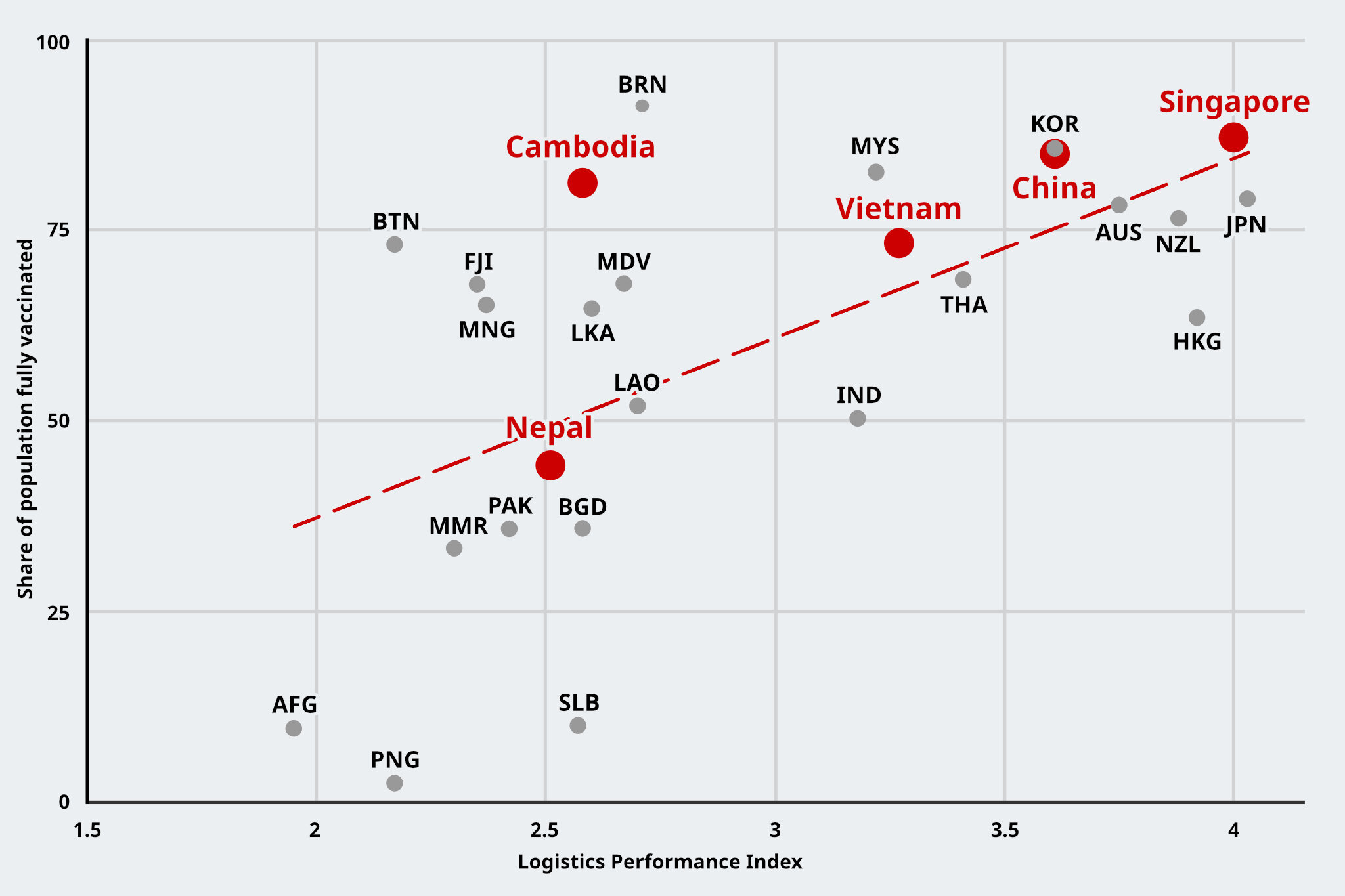With the supply of COVID-19 vaccines to many parts of the developing world set to be ramped up substantially this year, priority has shifted toward safely getting these vaccines into people’s arms. To this end, closing gaps in transport and distribution logistics will be vital to break the hold of the pandemic.
Data from the World Bank’s logistics performance index (LPI) database – a good proxy for transport and distribution logistics – show that Asian countries with stronger logistics performance are generally associated with higher vaccination rates (see Figure 1). The LPI is measured on a scale ranging from 1 to 5, with higher scores representing better performance on logistics, the network of services that support the physical movement of goods both within and across a country’s borders.

Figure 1: Countries with stronger logistics performance are associated with higher vaccination rates. Share of people fully vaccinated is from Our World in Data. Aside from selected highlights, data labels use International Organization for Standardization (ISO) country codes.
The more developed and geographically smaller economies in Asia, including South Korea, Singapore, New Zealand, Japan, and Malaysia have better than average logistics performance and a higher vaccination rate. Among these rich economies, the average LPI score is 3.6, and the average vaccination rate is about 75 percent of the population. Singapore leads the group with a vaccination rate of 87 percent, thanks to its high population density within an area of 728.3 square kilometers and strong logistics infrastructure that has allowed it to vaccinate a record number of its population. COVID zero policies have also contributed to the higher uptake of vaccines in China and Hong Kong.
In contrast, Myanmar, Pakistan, Bangladesh, Nepal, and other South Asian countries have poorer logistics performance and lower vaccination rates. A major challenge facing these lower income countries is that cold chain storage facilities are mainly concentrated in urban centers, like Kathmandu in the case of Nepal. Thus, transportation and distribution logistics are particularly challenging in rural and remote regions with limited power grids, roads and health workers. Where population is widely spread across a vast archipelago, it is also difficult to reach many people and hence distribute vaccines in a timely fashion.
The fact that Vietnam and Thailand have a relatively much higher vaccination rate in spite of having millions of people scattered over cities, villages, and the jungle clearly underscores the importance of developing infrastructure inputs to the supply chain that drive strong logistics performance. This is absolutely crucial in the South Asia region, which has a disproportionately poor logistics infrastructure. Additionally, intra-regional tariff and non-tariff barriers not only increase trade costs; they also hinder transport logistics in South Asia.
On the other hand, there is a group of countries including Bhutan, Cambodia, Brunei, and Sri Lanka that have relatively better vaccination rates but lower LPI scores, suggesting that other factors contribute to the uptake of vaccines in Asia. Some of these economies have benefited from small size and dense populations that have made it easier to vaccinate a large portion of the population. However, those that have set themselves apart from other logistics-poor countries and managed to achieve vaccination rates that are comparable with rates of some top Asian performers used technology to their benefit.
Take the case of Cambodia for example, which has a logistic performance index of only 2.58, and yet it has managed to vaccinate 81 percent of its population, surpassing both Japan and Australia (79 percent and 78.3 percent respectively). Cambodia’s success stems from the use of technology. Early on in the pandemic, it deployed technology, including the use of mobile apps for registering vaccination appointments and contact tracing. It also leveraged its economies of scale in the use of technology for educating people about history to help spread official information on COVID-19. Its KhmerVacc app has helped people to register for COVID-19 vaccines while also providing them with a QR coding technology for contact tracking.
Investments to support a strong transport and distribution logistics performance are therefore important to successfully deploy the large supply of vaccines that has been pledged this year, particularly in South Asia, which has a disproportionately poor logistics infrastructure. These investments should be complemented with peer-to-peer learning and knowledge sharing within Asia to further boost the region’s vaccination rate and thereby combat the COVID-19 pandemic. In this regard, lagging economies of Asia such as Bangladesh (which has the same logistics performance index as Cambodia), as well as economies like Afghanistan and Bhutan with some of the worst logistics performance indices (1.95 and 2.17 respectively) could learn from a country like Cambodia how use technology to help boost vaccination rates.

































